Jomon Journey of nawa to yajiri
English is available after Japanese.
For other languages, please click here

外に出ると、すでに日は暮れていた。冬至を間近に控えた12月、地平線は急ぎ足で太陽を西へと追いやり、夜の面積を確保したようだった。建物の裏手に続くアプローチが完全に闇に支配されていたので、学芸員Kさんの懐中電灯が照らすまで、そこに竪穴住居が立っていることすら気がつかなかった。きっと茅を束ねた屋根で覆われた竪穴住居は、そのストロー状の繊維の中に光を吸収してしまうに違いない。
穴ぐらのような住居内に降りると、ライトに照らされて、石を三角形に敷き詰めた石組みの炉が浮かび上がった。炉の手前側は土間を浅く掘りくぼめてあり、土器を3つ埋めた三角形の頂点部とひと続きになっている。複式炉だ。石組みの炉と土器の埋設部分からなるこの炉は、縄文時代中期末の東北南部で顕著に出土し、その核心地ともいえる福島県内で、約500基以上が見つかっている。
複式炉のことは、修復家をしている知人の工房で制作途中のレプリカを見たことがあり、気になっていた。妙に独創的なあの形。縄文時代に使われてきた石囲い炉(石を丸や四角に囲んだ素朴な炉)とはまったく趣が異なるものだし、ましてや囲炉裏とも違うよくわからないものだった。しかも、複式炉は土器や土偶に比べるとかなり地味な存在で、情報としてあまり出てくるものではない。だから、昨年の秋に「法正尻遺跡展3〜複式炉の時代」という企画展が福島県文化財センター白河館(通称:まほろん)で行われていることを知って、「あの複式炉か」と、レアなものを追うハンターのように色めき立ったのである。
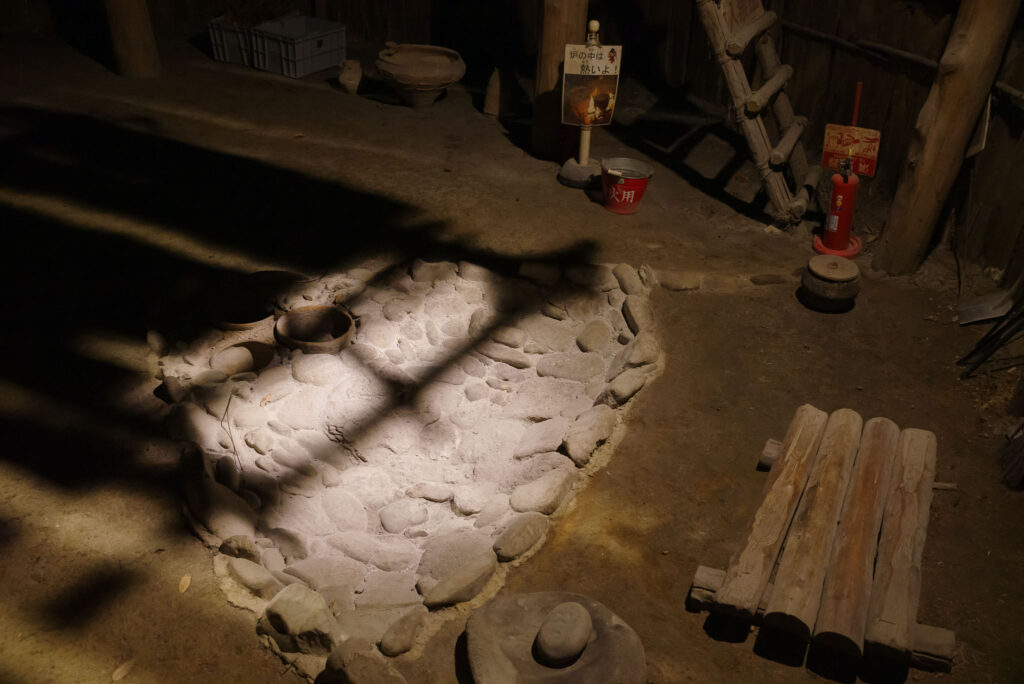
まほろんの屋外に復元された法正尻遺跡の複式炉
企画展は、猪苗代湖北西にある法正尻遺跡の変遷を3回に渡って展示するシリーズの最終回だった。ひとつの遺跡を3回に渡って特集するなんて、なかなかないこと。磐越自動車道の道路工事の際に見つかった法正尻遺跡は、縄文時代中期の1000年間にわたるムラの変遷が追える遺跡として、考古学的にも貴重なものらしい。
土坑(貯蔵穴)からきれいな状態で出土したという大木式を中心とする土器は、855点が国重要文化財に指定されている。会場にはそのうちの縄文時代中期後半、つまり複式炉の時代の土器が集められていた。肝心の複式炉は写真パネルのみだったが、その範囲が東北南部を中心に北は青森県、南は埼玉県、西は新潟県まで及ぶことを知ることができた。土器たちも見応えがあり、つい夢中になってKさんに質問をしていたら閉館時間を過ぎてしまい、慌てて日が暮れた後の屋外の複式炉を見にきたのだった。

企画展「法正尻遺跡展3 複式炉の時代―縄文集落の画期―」
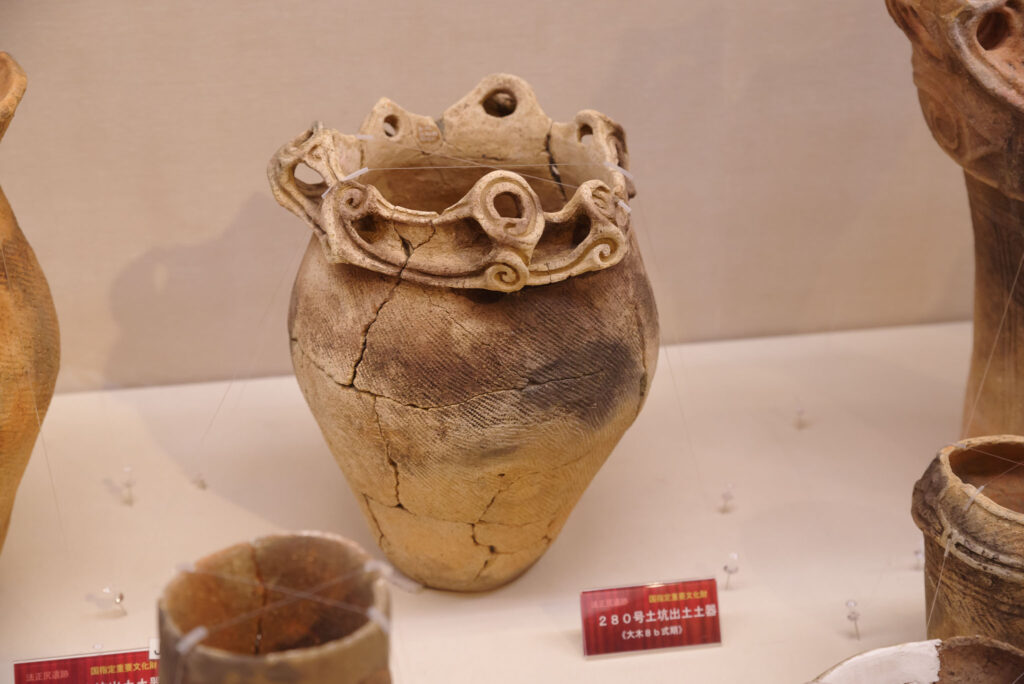
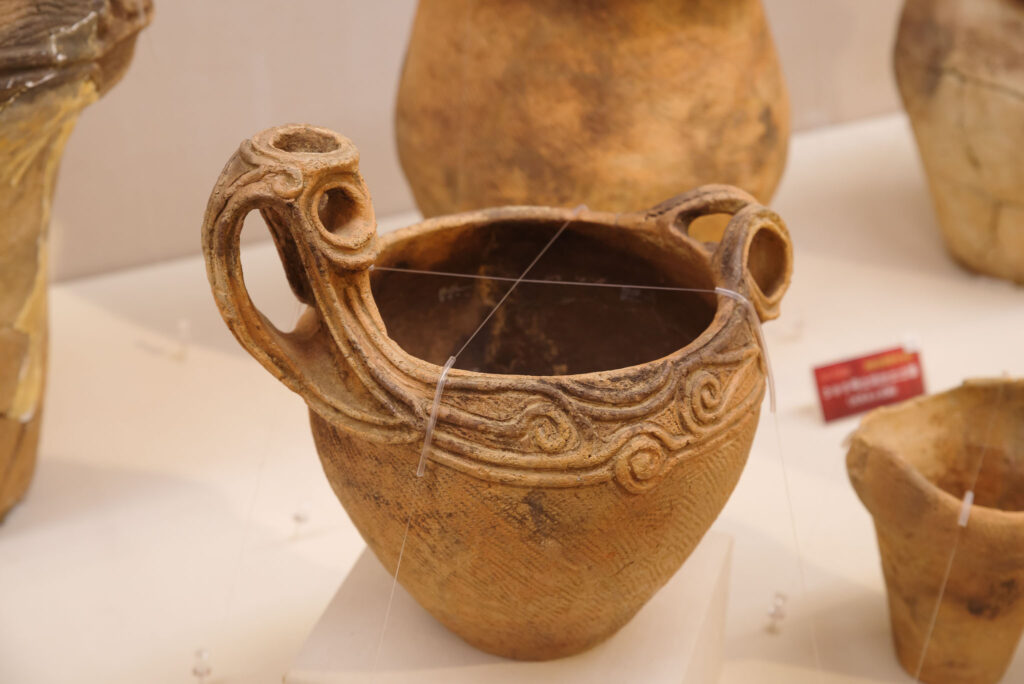
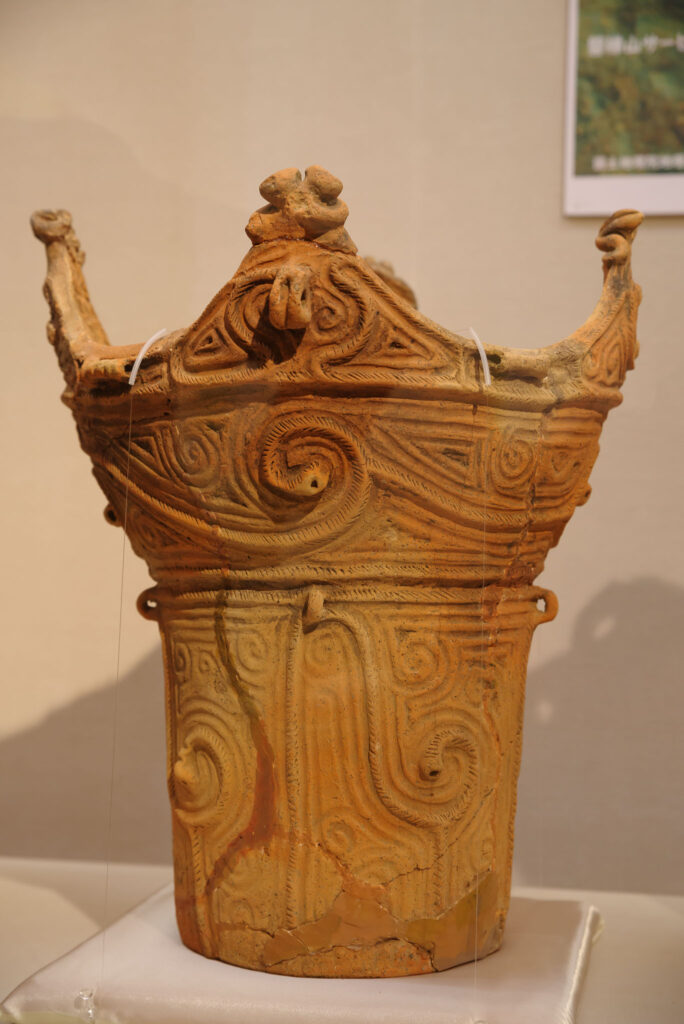
複式炉が登場する以前の大木7b〜8b期の土器たち
法正尻遺跡の大型住居を復元したという竪穴住居は、天井が高く、柱も梁も太くて、立派なつくりをしていた。Kさんの話では、首長の家や集会場の可能性があるという。土の匂いにまじって、燻された香ばしい匂いがする。毎週土曜日にこの複式炉で火を焚いているというKさんは、「そうしないと、カビが生えて虫や蛇までもが棲みついてしまう」のだという。そういえば、以前、別の遺跡で竪穴住居に蛇が卵を生みつけるという話を聞いたことがあるが、なるほど、蛇にとって竪穴住居は居心地がよいものらしい。だからこそ煙で追い払う必要があるのだ。
竪穴住居内の炉というものは、おもに種火の保存用で、食事を作るメインの炉は外にあったという説もある。たしかに大きな火を焚いたら、茅葺きの家は燃えてしまいそうな気がする。そのためか複式炉の上に炉棚が吊り下げられ、火が燃え移らないようになっていた。実際にこのような設備があったかどうかはわからないが、少なくともこれだけ大きな炉ならあって然るべしということだろう。「石は蓄熱性があるから、この上で火を焚いたらかなり暖かかったんじゃないかな」と廣川。寒い東北の冬に暖房は不可欠だ。炉の火は家の灯りにもなる。ここで火が焚かれている様子を想像するだけで、ほっこりと暖かい気持ちになった。
複式炉の手前側は、周囲の床より数センチ低い前庭部となっていて、両側に土留めのように石が置かれていた。「ここはとくに踏み固められているんですよね」とKさん。踏みしめられた土はツヤを帯びる。以前、新潟県津南町で発掘中の住居の床面を裸足で歩かせてもらったことがあったが、しっとりと肌に吸い付くような踏み心地がしたものだった。土がそのように締まった状態になっているということは、火の回りの作業をここで行なっていたということだろう。
石組みに埋められた土器はいったい何に使ったのだろうか。Kさんに聞くと、土器に被熱の痕跡があり、火種や灰を貯めていたという説があるそうだ。灰は山菜や木の実のアク抜き用に使えるもの。灰のアルカリ性でえぐみや渋みを中和するアク抜きの技術は、縄文時代から現代まで脈々と続く技術のひとつだ。土器とひとつながりになった複式炉は、メインの炉でできた灰をストックするのに都合がよいように思えた。
土器の中に燃えさしを入れて、串刺しにした肉を土器の上に渡せばオーブンのように使えるのではないだろうか。すると、コンロとオーブンと収納がひとつになった複式炉は、もはやシステムキッチンである。これはかなりの発明だと思った。
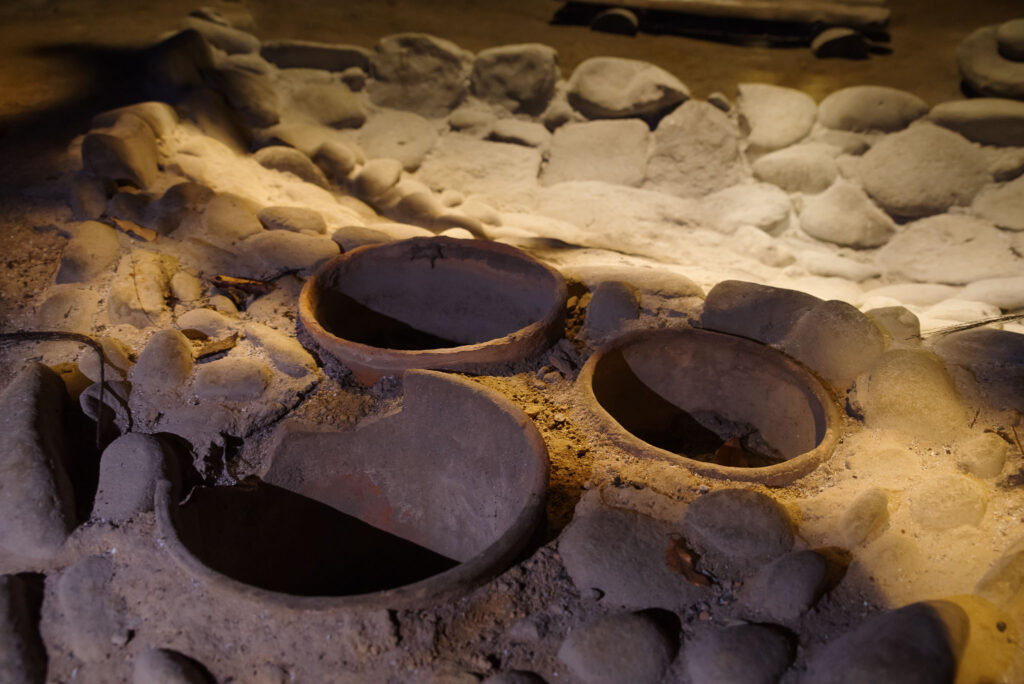
複式炉に埋設された土器
しかし、システムキッチン説に対するKさんの反応は冷静そのもの。
「複式炉が便利さを求めたものかどうかはわかりません。便利なものならそのまま持続し、形を変えて進化してもいいはずなのに、複式炉は300年ほどで廃れてしまい、以前の石囲い炉に戻るんです」
確かにシステムキッチン説は飛躍しすぎだった。この時代のデコラティブな土器を見よ。縄文中期の東日本の土器はいかにゴージャスであるか、いかに美しいかに重きを置いたものが少なくない。この時代の人々は、煮たり注いだりという機能を充実させることよりも、土器の装飾を優先させてきたのだ。そのような人々が、いきなり便利志向になるというのもおかしな話だ。
それに複式炉以前の住居の炉は、地面で直接火を焚く地床炉や石で囲んだ素朴な石囲い炉なのだ。どんなに土器の造形が美しく豪華になったとしても、炉の基本形というのは、何千年もの間大きく変化していない。かたくなに素朴な炉を使い続けた人々が、どんな必要性があって、石のオブジェのような炉を作り始めたのだろうか。
わからないことはほかにもある。複式炉が登場すると、在地の中期大木式土器の流麗なデザインが大きな変貌をとげるのだ。装飾過多な突起が失われ、縄を転がした地文の上に太いUの字や渦巻き文様を描いた、大胆でのっぺりとした印象の見た目に様変わりする。その変遷は企画展示室で見たばかりだった。
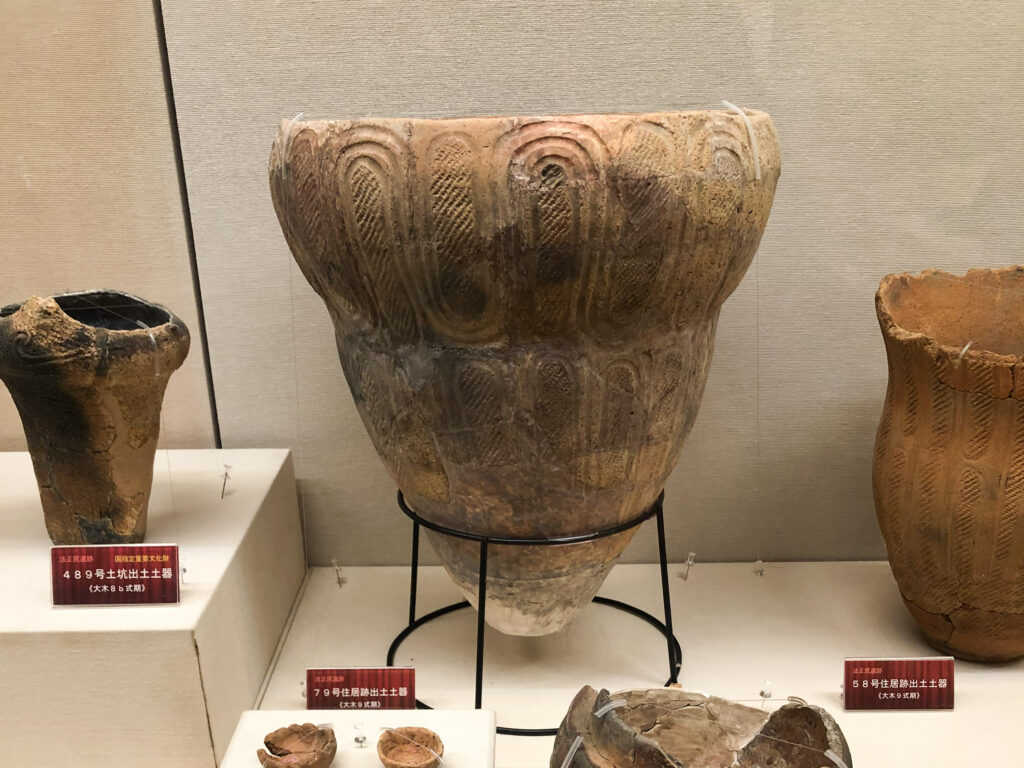
複式炉の時代に作られた大木9式土器
この現象について、Kさんの上司であるまほろんの副館長は、「人々の関心が土器から石へ移ったのではないか」と考えている。「あれだけ土器にこだわった人たちが、複式炉の時代になるとさっぱりした土器しか作らなくなるのは、石に情熱を注いだからではないか」と、副館長の代わりにKさんが説明してくれた。「石に情熱を注ぐ」とはどういうことだろう? もっと話を聞いてみたいと思ったが、時間切れとなってしまった。
深夜になり、雪が降り始めた。東京から来た私たちにとって、この冬初めてみた雪だった。しかし、雪よりも強烈なのは風だった。宿泊した郡山のホテルの部屋は、山から吹き下ろす北風が当たると、ゆるんだ窓の隙間から甲高い不協和音が鳴り響いた。やがて風が弱まると静けさがやってくるのだが、ほどなくして風は再び唸り始める。まるで風自体が意志を持っているかのようだった。
翌日も相変わらず風は強かった。青空に粉雪が舞うなか、私たちは東北最大の規模を誇る大安場古墳のガイダンス施設で市内の縄文遺跡から出た優品を見学し、郡山市に隣接する三春町の歴史民俗資料館で不思議な表情の土偶に出会った。胸から下は欠損しているが、肩周りは筋肉隆々で、顔はちびまるこちゃんに出てくる花輪くんのようにすました表情をしていた。こういう面白いものに出会えるから縄文の旅はやめられない。
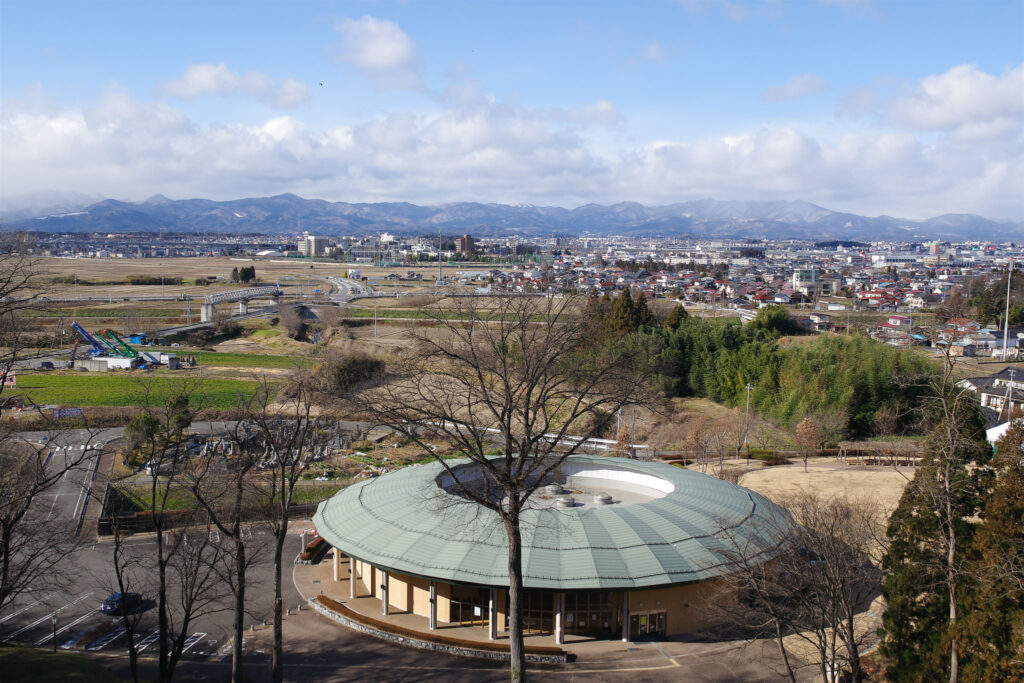
大安場古墳のガイダンス施設は古墳から出た車輪石をモチーフにしている
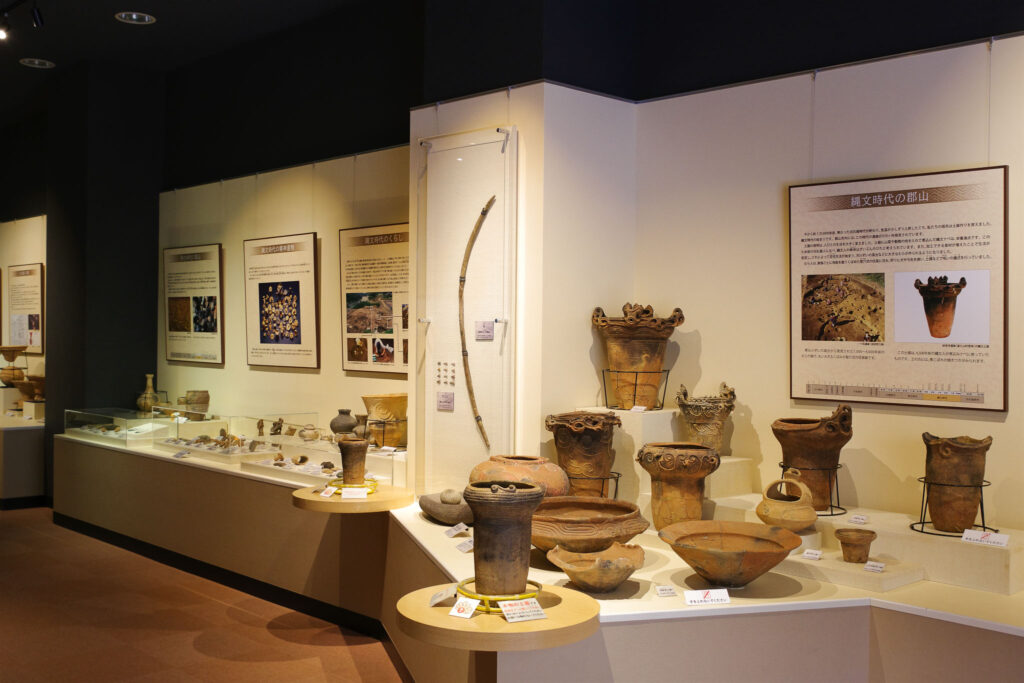
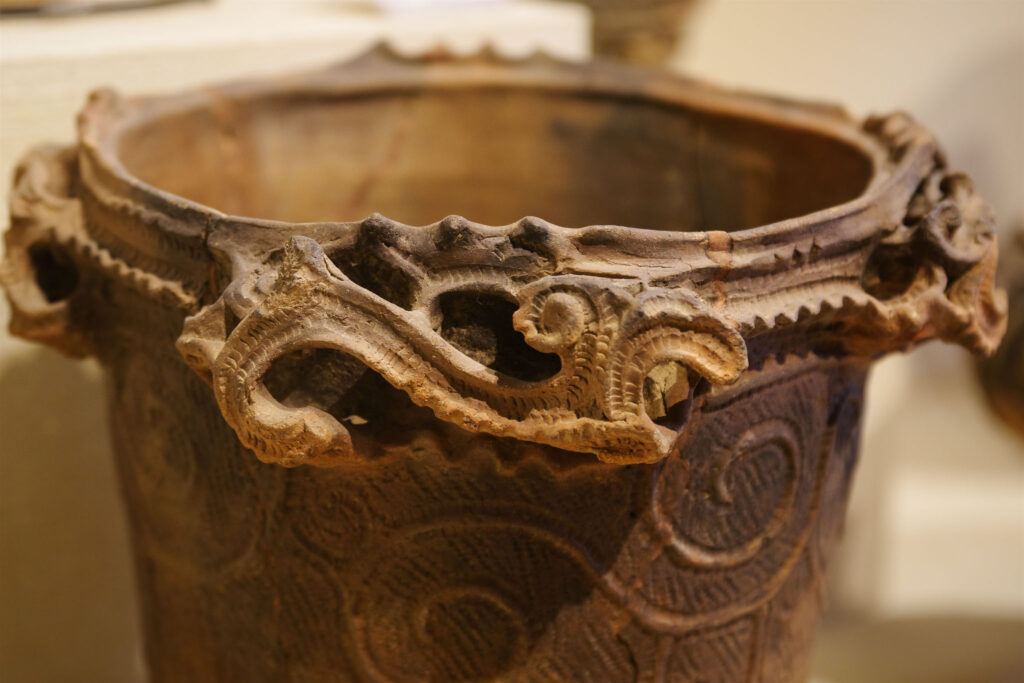
古墳のガイダンス施設と思いきや、郡山の縄文土器の優品も
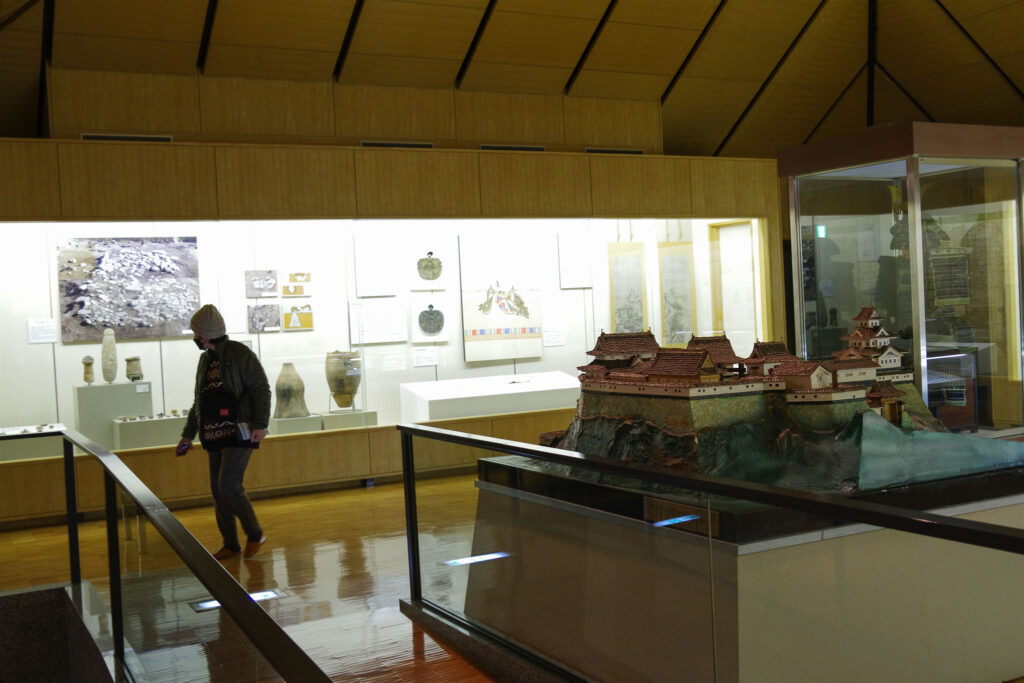
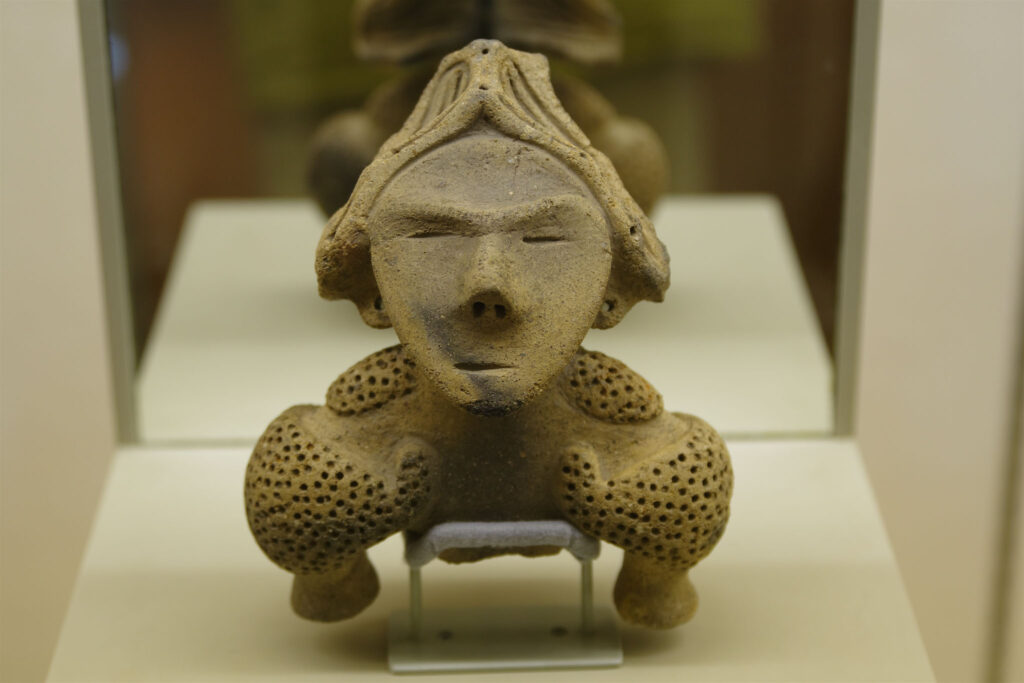
三春町の歴史民俗資料館にあったすました顔の土偶。肩から下は欠損
その後、私たちはこの日の宿泊地である安達太良山方面に進路をとった。吹雪を予想して、暗くなる前に早めに宿に入るつもりだった。しかし、のどかな県道を車で走っていると、視界に「ペグマタイト岩脈」の文字が飛び込んできた。地質好きの廣川としては、見逃すことはできない。引き返すと、なんと乳白色をした巨大なペグマタイトが御神体のめずらしい神社である。花崗岩の一種で石英や長石を含むペグマタイトは、主に光学レンズや陶磁器の原料になるらしく、その岩脈が露出しているこのあたりの地域では、昭和の初めごろに採掘が行われていたらしい。参道の入り口には、二股に別れた杉の巨木が門のようにすっくと生えている。その樹齢から想像するに、ペグマタイトの採掘以前からここに植えられていたものだろう。白く輝くペグマタイトの岩脈を聖域にした、昔の人々の気持ちを感じるひとときとなった。
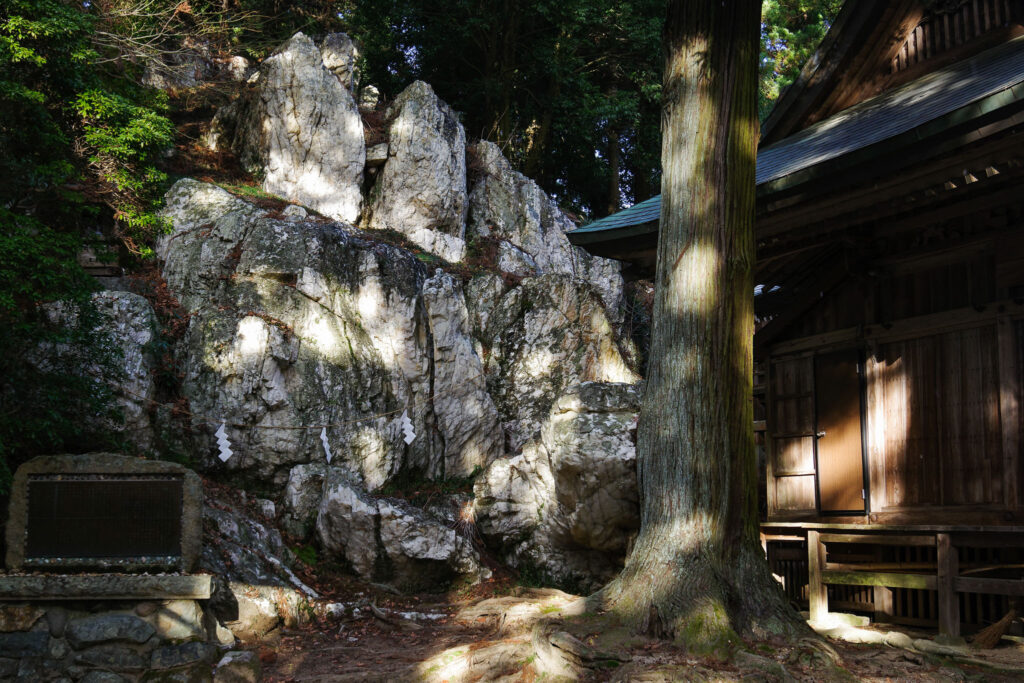
郡山市にある鹿島大神宮の国指定天然記念物ペグマタイト岩脈
先を急いでいるはずなのに、さらにもう一箇所立ち寄りたい場所があった。安達太良山の裾野に広がる二本松市には、原瀬上原遺跡がある。ここもまた複式炉が出ている縄文遺跡だった。原瀬川に面した河岸段丘上の雑木林に囲まれた広場には、冬の夕暮れ時の弱々しい太陽の光を受けて2棟の復元住居が建っていた。手入れする人がいないのか、屋根がひしゃげて朽ちかけており、まほろんの復元住居で感じた豊かさは微塵も感じられなかった。複式炉があるはずと中をのぞきこんだが、確認できないほど荒れ果てていたので、早々に車に退散したのだった。
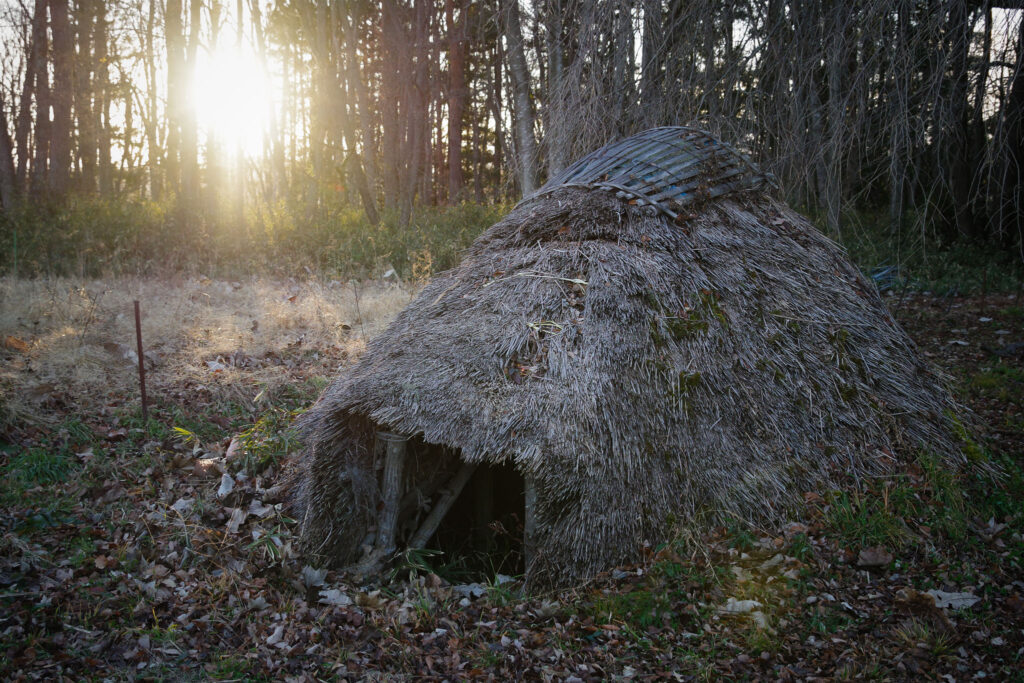
二本松市、原瀬上原遺跡の朽ちかけた復元住居
岳温泉を過ぎると雪道になった。路面に積もった新雪は強い風に巻き上げられ、粉を吹いたような有様になっていた。昨夜ホテルで聞こえた風の出所はここだと直感する。スタッドレスタイヤをはいてきたので車は安定していたが、針葉樹の山肌の至るところにつむじ風が雪煙をあげていて、来てはいけない場所に来てしまったような感じ。はるか北方のシベリアから吹いてきた寒波が山にぶつかり、行き場を失ったかのように右往左往しているのだ。地吹雪の中、目的地の温泉宿に辿り着き、やっと人心地ついた。よし今晩は、鉄分の多い濃厚な温泉で体の芯まで温まるぞ。
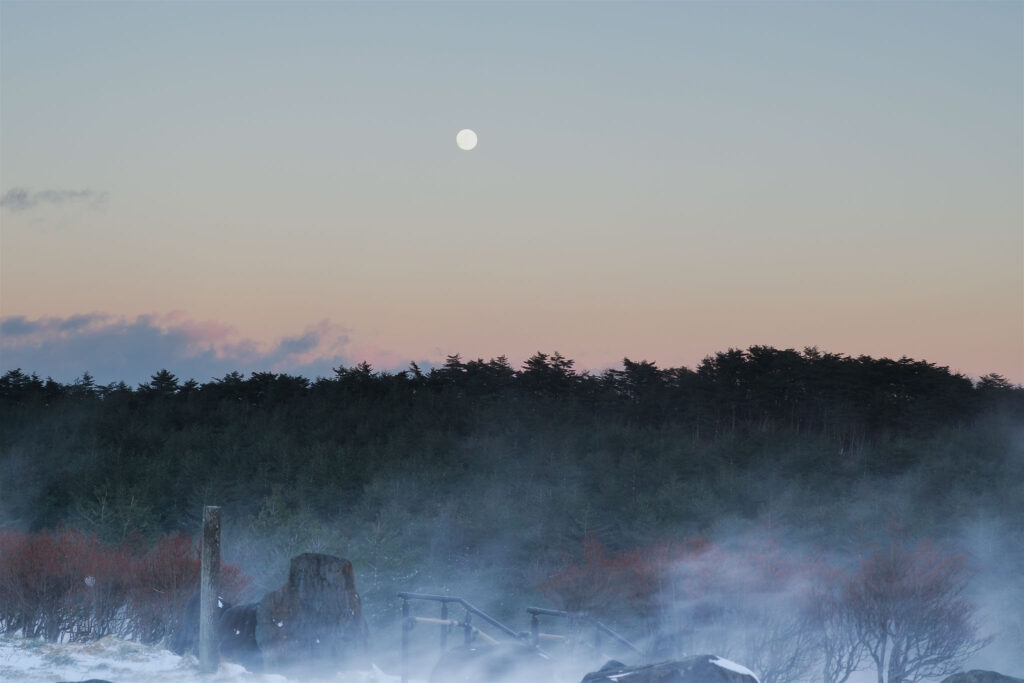
道の駅「つちゆ」から見た地吹雪越しの夕景
後編へ続く
草刈朋子:文 廣川慶明:写真
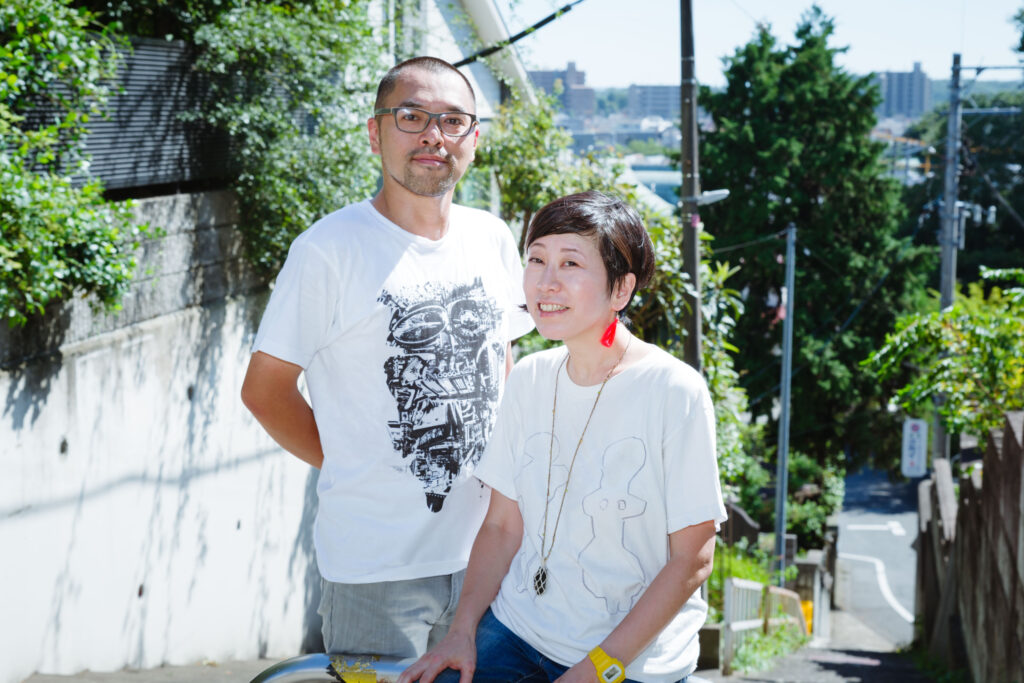
縄と矢じり
文章担当の草刈朋子と写真担当の廣川慶明による縄文探求ユニット。ともにNPO法人jomonismのメンバーとして活動するほか、全国の縄文遺跡と考古館や郷土館をめぐる縄文旅をしながら各地の縄文のカタチ、環境から読み解ける先史時代の価値観を探求中。
http://nawatoyajiri.com
*’Fukushiki-ro’ is a large-size fireplace constructed from an arrangement of large riverbed stones.
When I went outside, the sun was already setting. With the winter solstice just around the corner in December, the horizon seemed to be in a hurry to drive the sun westward to make room for the night. The path leading to the back of the building was completely dominated by darkness, so I did not even realize that the pit dwelling was standing there until curator K’s flashlight shined on it. Surely the pit dwelling, covered with a thatched roof, must absorb light in its straw-like fibers.
When we descended into the cave-like dwelling, the light revealed a masonry furnace with stones laid out in a triangular shape. On the front side of the furnace, the earthen floor was shallowly dug and hollowed out, and was connected to the apex of the triangle where three earthenware vessels were buried. It is a “Fukushiki-ro” These furnaces, consisting of a masonry furnace and buried earthenware, were excavated at the end of the Middle Jomon Period in the southern Tohoku region, and more than 500 have been found in Fukushima Prefecture, which can be considered the core of the region.
I had been curious about the Fukushiki-ro because I had seen a replica in progress in the workshop of an acquaintance who is a restorer. That strangely original shape. It was completely different from the stone surround furnaces used in the Jomon period (rustic furnaces made of round or square stones), much less a fireplace, which I did not understand.
Moreover, compared to earthenware and clay figurines, Fukushiki-ros are quite humble and not much information is available about them. That is why I was so excited when I learned that the “Hosho-jiri Site Exhibition 3: The Age of the Fukushiki-ro” was being held last fall at the Fukushima Cultural Property Centre, Shirakawa Branch (commonly known as “Mahoron”), I was like a hunter after something rare: “Oh, that Fukushiki-ro”.

Fukushiki-ro from the Hoshojiri site restored outside of Mahoron
The special exhibition was the last in a series of three exhibits on the changes at the Hoshojiri site northwest of Lake Inawashiro. It is not often that a single archaeological site is featured three times. The Hoshojiri site, which was discovered during the construction of the BAN-ETSU expressway, is said to be a valuable archaeological site as it traces the transition of the village over a period of 1,000 years in the middle Jomon period.
855 pieces of earthenware, mainly of the Oki type, which were excavated in clean condition from clay pits (storage pits), have been designated as National Important Cultural Properties of Japan. The exhibition hall was filled with pottery from the latter half of the Middle Jomon Period, or the period of the Fukushiki-ro. Although there were only photo panels of the furnaces, we learned that the range of the furnaces was centered in the southern Tohoku region, extending from Aomori Prefecture in the north to Saitama Prefecture in the south and Niigata Prefecture in the west. The earthenware vessels were worth seeing, and I was so absorbed in asking Mr. K questions that it was past closing time, so I hurried to see the outdoor furnace after dark.

The special exhibition “Hosho-jiri Site Exhibition 3: The Age of the Fukushiki-ro – Epoch-making Jomon Settlement -”



Pottery from the Oki 7b-8b period before the appearance of the Fukushiki-ro
The pit house, a reconstruction of a large dwelling at the Hoshojiri site, had a high ceiling, thick pillars and beams, and was of fine construction. According to Mr. K, it could have been a chief’s house or a meeting place. The smell of smoky air was mixed with the smell of soil. Mr. K says that he builds a fire in this Fukushiki-ro every Saturday, “otherwise, mold will grow and insects and even snakes will live in it,” he said. I have heard that snakes lay eggs in pit dwellings at another archaeological site, and it seems that pit dwellings are a comfortable place for snakes. That is why it is necessary to scare them away with smoke.
Some people believe that the furnace inside the pit dwelling was mainly for preserving the seed fire, and that the main furnace for cooking meals was located outside. It is true that a thatched house would likely burn down if a large fire was built. This may be the reason why a hearth shelf was hung above the Fukushiki-ro to prevent the fire from spreading. I don’t know if such a facility actually existed, but at least with a furnace this large, it would seem that it should have. “The stones have heat storage properties, so it must have been quite warm when the fire was built on top of it.” Hirokawa said. Heating is essential in the cold Tohoku winters. A fire in the furnace can also light the house. Just imagining a fire burning here gave me a warm feeling.
The front side of the Fukushiki-ro was a few centimeters lower than the surrounding floor, and stones were placed on both sides as a kind of soil barrier. “This area is especially hardened.” said Mr. K. The soil has a glossy sheen to it. I once walked barefoot on the floor of a house being excavated in Tsunan Town, Niigata Prefecture, and it felt as if I was stepping on something that was soft and comfortable against my skin. I imagine that the fact that the soil is in such a compacted state means that work around the fire must have been done here.
When I asked Mr. K what the earthenware buried in the masonry was used for, he replied that there were traces of heat exposure on the earthenware, leading him to the theory that it was used to store firewood or ashes. The ashes can be used to remove the scum from wild vegetables and nuts. The technique of removing scum by using the alkalinity of ash to neutralize bitterness and astringency is one that has been handed down from the Jomon period to the present day. The Fukushiki-ro, connected to the earthenware, seemed to be a convenient way to stock the ashes from the main furnace.
It could be used like an oven by placing a burner inside the earthenware vessel and passing the skewered meat over the top of the vessel. Then, the Fukushiki-ro, which is a stove, oven, and storage all in one, is now a system kitchen. I thought this was quite an invention.

Earthenware buried in a Fukushiki-ro
However, Mr. K’s reaction to the system kitchen theory was dispassionate.
“We do not know if the Fukushiki-ro is a matter of convenience. If they were convenient, they should have lasted and evolved in different forms, but after 300 years or so, they fell into disuse and reverted to the stone hearth furnaces of the past.”
The system kitchen theory was certainly a leap too far. Look at the decorative earthenware of this period. Not a few of the earthenware of the eastern part of the Middle Jomon period emphasizes how gorgeous or beautiful they are. The people of this period prioritized the decoration of earthenware over the fulfillment of functions such as boiling and pouring. It is strange that such people would suddenly become convenience-oriented.
In addition, the furnaces in pre-Fukushiki-ro dwellings were either ground floor furnaces called Jisho-ro, in which the fire burned directly on the ground, or simple stone hearth furnaces. No matter how beautiful and gorgeous earthenware has become, the basic form of a furnace has not changed significantly over thousands of years. What necessity could have compelled people who had stubbornly continued to use simple furnaces to start making furnaces that looked like stone objects?
There are other things I don’t know. The appearance of the Fukushiki-ro marks a major transformation in the flowing design of local Middle Oki pottery. The overly decorative protrusions were lost, and the appearance was changed to a bold, flat appearance with thick U-shaped and spiral patterns painted over a ground pattern of rolled ropes. I had just seen this transition in the planning exhibition room.

Oki 9 earthenware from the period of the Fukushiki-ro
Mr. K’s supervisor, the vice curator of Mahoron, believes that this phenomenon “may have shifted people’s interest from earthenware to stone. Mr. K explained on behalf of the vice curator that “the reason why people who were so particular about earthenware stopped making only plain earthenware in the period of Fukusiki-ro is because they were passionate about stone. What does “passionate about stones” mean? I would have liked to hear more, but time was running out.
Late at night, it began to snow. For those of us from Tokyo, this was the first snow we had seen this winter. However, what was more intense than the snow was the wind. The hotel room in Koriyama, where we stayed, rang out a high-pitched cacophony through the loose windows as the northerly wind blowing down from the mountains hit the room. Eventually, the wind would die down and a hush would descend, but soon the wind would begin to roar again. It was as if the wind itself had a will.
The next day, the wind was as strong as ever. Under a blue sky with powdery snow flurries, we visited the guidance facility of the Oyasuba ancient tombs at Oyasuba historic Park, the largest of its kind in Tohoku, to see the excellent artifacts from the city’s Jomon ruins. Then, at the History and Folklore Museum in Miharu Town, adjacent to Koriyama City, we encountered a curious-looking clay figurine. It was missing from the chest down, but had good muscle tone around his shoulders and a face as composed as Hanawa-kun’s in Chibi Maruko-chan. It is this kind of interesting thing that makes a trip to the Jomon region so interesting.

The guidance facility at the Oyasuba ancient tombs is based on a wheel stone from the burial mound.


A guidance facility for ancient burial mounds, but also excellent pieces of Koriyama’s Jomon pottery


A somber-faced clay figure from the Miharu Town Museum of History and Folklore. The body is missing from the shoulders down.
We then set our course for Mt. Adatara, where we would be staying for the day. Forecasting a blizzard, we planned to get into the lodge early, before dark. However, as we drove along a peaceful prefectural road, the words “pegmatite veins” popped into view. As a geology fan, Hirokawa could not miss it.
Turning back, we found a huge, milky-white pegmatite shrine with an unusual deity. Pegmatite is a type of granite that contains quartz and feldspar, and is mainly used to make optical lenses and ceramics, and in this area where its veins are exposed, mining was apparently conducted around the beginning of the Showa period (1926-1989). At the entrance to the approach, a huge cedar tree, split in two, grows neatly like a gate. As one might imagine from the age of the tree, it must have been planted here before the mining of pegmatites. It was a moment for us to feel the feelings of the people of the past who made the shining white veins of pegmatite rock a sanctuary.

Pegmatite vein, a national natural monument at Kashima Grand Shrine in Koriyama City
Although we were supposed to be in a hurry, there was one more place we wanted to stop by. In Nihonmatsu City, which lies at the foot of Mount Adatara, there is the Harase-Uwahara Ruins. This was another Jomon site where a Fukushiki-ro was found. Two reconstructed dwellings stood in a wooded plaza on a river terrace facing the Harase River, bathed in the weak sunlight of winter dusk. The roof was crumbling and rotting, as if no one had taken care of it, and there was not the slightest hint of the richness that I had felt in Mahoron’s restored dwelling. I peeked inside to see if there should be a duplex furnace, but it was in such disrepair that I could not see it, so we quickly retreated to the car.

Decaying reconstructed dwelling at the Harase-Uwahara site, Nihonmatsu City
After passing Dakeonsen, the road became snow-covered. The fresh snow piled up on the road surface was blown up by the strong wind and looked like powder. I intuit that this is where the wind I heard at the hotel last night was coming from. I had put on studless tires, so the car was stable, but the whirlwind was blowing snow plumes all over the coniferous mountainsides, and I felt like I had come to a place I shouldn’t have. A cold wave blowing from Siberia in the far north crashed into the mountains and swept right and left, as if it had lost its way. We finally arrived at our destination, a hot spring resort, in the midst of a blizzard, and finally felt at home. All right, tonight, I will warm myself to the core in the rich, iron-rich hot spring water.

Evening view over the ground snow seen from “Tsuchiyu” Roadside Station
To be continued to Part 2
Text : Tomoko Kusakari, Photo : Yoshiaki Hirokawa
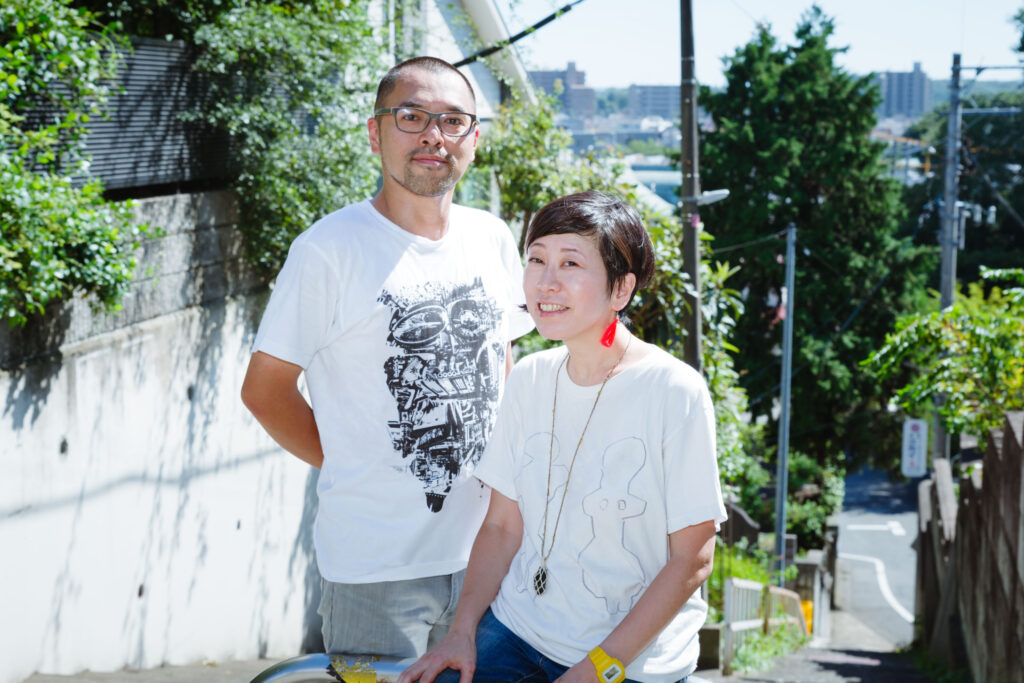
nawa to yajiri
(it means “Rope and Arrowhead”)
A unit for exploring the Jomon by Tomoko Kusakari (writing) and Yoshiaki Hirokawa (photography).
In addition to working as members of the NPO Jomonism, they also travel around Japan visiting Jomon ruins, archaeological sites and local museums, exploring the prehistoric values that can be deciphered from the forms and environments of the Jomon.
http://nawatoyajiri.com